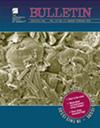Pervasive Neoarchean melting of subducted sediments generating sanukitoid and associated magmatism in the North China Craton, with implications for the operation of plate tectonics
IF 3.7
1区 地球科学
Q1 GEOSCIENCES, MULTIDISCIPLINARY
引用次数: 0
Abstract
The Mesoarchean to Neoarchean period (ca. 3.0−2.5 Ga) is the most important stage during the emergence and evolution of plate tectonics. However, plate subduction at this time may have been less stable and perhaps more susceptible to the lubrication effect of sediments than the modern counterpart. Such predictions have not yet been verified by field-based investigations. In this work, we identified two types of rock units (i.e., sanukitoids and associated adakitic suites, exposed in the Eastern Hebei Complex of the North China Craton) and illustrated their petrogenesis and tectonic context through field, geochronologic, geochemical, and isotopic investigations. Laser ablation−inductively coupled plasma−mass spectrometry zircon U-Pb analyses suggest that the two magmatic suites formed within a relatively short time span of ca. 2596−2544 Ma and ca. 2559−2533 Ma, respectively. The sanukitoids are composed of meta-andesites and diorite porphyrites and characterized by relatively high MgO (3.94−5.62 wt%), Mg# (50−61), Cr (73−343 ppm), and Ni (37−111 ppm) values. The adakitic rocks are composed of granodiorite-granite gneisses and have relatively high Sr (316−1001 ppm) and low Y (7−13 ppm) and Yb (0.83−1.37 ppm) contents, and relatively high Sr/Y (36−89) and La/Yb (16−45) ratios. Rocks from both suites exhibit depletions of Nb, Ta, and Ti and have similar Sr-Nd-Hf-Zn isotopes: variable (87Sr/86Sr)i (0.7002−0.7053), weakly positive εNd(t) (+0.3 to +1.7) and εHf(t) (+1.8 to +6.8), and slightly heavy δ66Zn (0.30‰−0.36‰). These geochemical characteristics indicate that the sanukitoids were derived from the melting of subducted sediments followed by melt-mantle interaction, whereas the adakitic rocks were produced by direct partial melting of subducted plate (including tonalite-trondjhemite-granodiorite melts) under a garnet stability field with minor sediments. Such distinct magmatic rock associations, together with the coeval charnockites and tholeiites with diverse compositions in the adjacent area, can be best explained by a slab breakoff model. Further, events associated with slab breakoff are likely to represent a transition of a quasi-plate tectonic regime, characterized by multiple, continuous, and stagnant attempts to start the modern-style subduction on Earth. In addition, the emergence of sanukitoids and associated magmas symbolized the onset of supracrustal recycling into the mantle. Combined with the Nd-Hf-Zn isotopes of diverse magmatic rocks in the North China Craton that are comparable to other Precambrian magmatic rock suites worldwide, we suggest that supracrustal recycling symbolized the onset of plate tectonics since ca. 3.0 Ga, and by inference played a key role in the development of subduction-driven plate tectonics in addition to Earth’s secular cooling.华北克拉通新元古代俯冲沉积物的普遍熔融产生三基性岩及相关岩浆活动,对板块构造作用的影响
中新元古代至新元古代(约 3.0-2.5 Ga)是板块构造出现和演化过程中最重要的阶段。然而,与现代的板块俯冲相比,这一时期的板块俯冲可能不够稳定,也许更容易受到沉积物润滑作用的影响。这种预测尚未得到实地调查的验证。在这项工作中,我们确定了两类岩石单元(即出露于华北克拉通河北东部复合体的三绢云母和相关的阿达克岩套),并通过野外、地质年代、地球化学和同位素调查说明了它们的成岩学说和构造背景。激光烧蚀-电感耦合等离子体质谱锆石 U-Pb 分析表明,这两个岩浆岩套分别形成于约 2596-2544 Ma 和约 2559-2533 Ma 的较短时间内。萨努基托岩由偏安岩和闪长岩斑岩组成,具有相对较高的氧化镁(3.94-5.62 wt%)、镁(50-61)、铬(73-343 ppm)和镍(37-111 ppm)值。黑云母岩由花岗闪长岩-花岗片麻岩组成,硒含量相对较高(316-1001 ppm),钇(7-13 ppm)和镱(0.83-1.37 ppm)含量较低,硒/钇(36-89)和喇/镱(16-45)比率相对较高。两个岩套中的岩石都显示出 Nb、Ta 和 Ti 的贫化,并具有相似的 Sr-Nd-Hf-Zn 同位素:可变的 (87Sr/86Sr)i (0.7002-0.7053)、弱正的 εNd(t) (+0.3 至 +1.7) 和 εHf(t) (+1.8 至 +6.8),以及稍重的 δ66Zn (0.30‰-0.36‰)。这些地球化学特征表明,萨努基托岩是由俯冲沉积物熔融后经熔融-地幔相互作用而形成的,而阿达基特岩则是由俯冲板块(包括辉长岩-闪长岩熔体)在石榴石稳定场下直接部分熔融产生的,沉积物较少。这种截然不同的岩浆岩组合,以及邻近地区同时期不同成分的查诺克岩和托勒密岩,可以用板块断裂模型得到最好的解释。此外,与板块断裂相关的事件很可能代表了准板块构造体系的过渡,其特点是多次、持续和停滞地尝试启动地球上的现代式俯冲。此外,萨努基托岩和相关岩浆的出现象征着上地壳向地幔再循环的开始。结合华北克拉通地区不同岩浆岩的钕-铪-锌同位素与全球其他前寒武纪岩浆岩套系的相似性,我们认为上地壳再循环标志着板块构造作用自约3.0Ga开始,并通过在华北克拉通地区的钕-铪-锌同位素的研究,揭示了上地壳再循环与板块构造作用的关系。据此推断,除了地球的世态冷却之外,超岩浆循环在俯冲驱动的板块构造的发展过程中也发挥了关键作用。
本文章由计算机程序翻译,如有差异,请以英文原文为准。
求助全文
约1分钟内获得全文
求助全文
来源期刊

Geological Society of America Bulletin
地学-地球科学综合
CiteScore
9.30
自引率
8.20%
发文量
159
审稿时长
4-8 weeks
期刊介绍:
The GSA Bulletin is the Society''s premier scholarly journal, published continuously since 1890. Its first editor was William John (WJ) McGee, who was responsible for establishing much of its original style and format. Fully refereed, each bimonthly issue includes 16-20 papers focusing on the most definitive, timely, and classic-style research in all earth-science disciplines. The Bulletin welcomes most contributions that are data-rich, mature studies of broad interest (i.e., of interest to more than one sub-discipline of earth science) and of lasting, archival quality. These include (but are not limited to) studies related to tectonics, structural geology, geochemistry, geophysics, hydrogeology, marine geology, paleoclimatology, planetary geology, quaternary geology/geomorphology, sedimentary geology, stratigraphy, and volcanology. The journal is committed to further developing both the scope of its content and its international profile so that it publishes the most current earth science research that will be of wide interest to geoscientists.
 求助内容:
求助内容: 应助结果提醒方式:
应助结果提醒方式:


